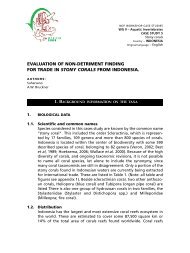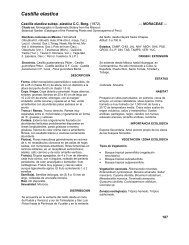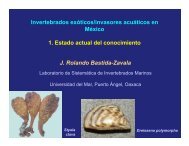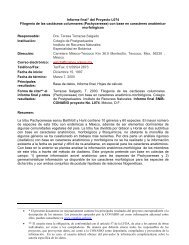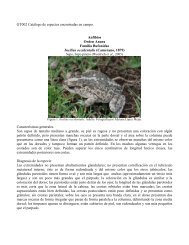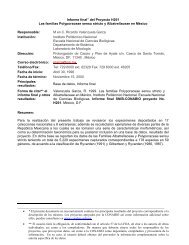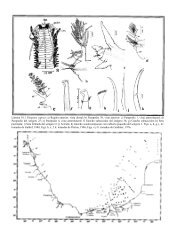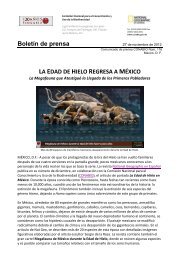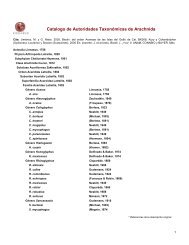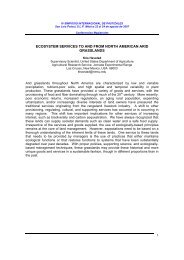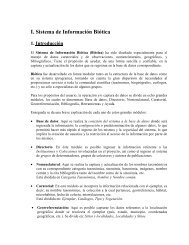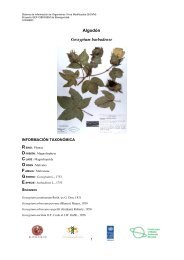Bursera citronella en la cuenca del río Papagayo - Conabio
Bursera citronella en la cuenca del río Papagayo - Conabio
Bursera citronella en la cuenca del río Papagayo - Conabio
Create successful ePaper yourself
Turn your PDF publications into a flip-book with our unique Google optimized e-Paper software.
<strong>Bursera</strong> <strong>citronel<strong>la</strong></strong> <strong>en</strong> <strong>la</strong> cu<strong>en</strong>ca <strong>del</strong> <strong>río</strong> <strong>Papagayo</strong><br />
David Espinosa<br />
Introducción<br />
El nombre ‘xochicopal’ aparece <strong>en</strong> <strong>la</strong>s primeras re<strong>la</strong>ciones de historia natural de México.<br />
Francisco Hernández (1570), lo describe como un árbol que produce una resina muy<br />
apreciada por los indíg<strong>en</strong>as mexicanos, distingui<strong>en</strong>do el que crece <strong>en</strong> Colima y Jalisco de<br />
<strong>del</strong> que crece <strong>en</strong> <strong>la</strong> cu<strong>en</strong>ca ori<strong>en</strong>tal <strong>del</strong> Balsas, ‘<strong>en</strong>tre los Teocaltzinc<strong>en</strong>ses’ (Teocaltzingo,<br />
Guerrero). Fray Juan Navarro (1809) incluye <strong>en</strong> su Jardín Botánico al xochicopal y lo<br />
describe como ‘x’, m<strong>en</strong>cionando que el nombre local <strong>en</strong> l<strong>en</strong>gua vulgar era ‘xarapiscua’,<br />
posiblem<strong>en</strong>te <strong>en</strong> purépecha.<br />
Ya <strong>en</strong> el periodo post-lineano, La L<strong>la</strong>ve describe a Amyris linaloe, cuyo género es<br />
adscrito actualm<strong>en</strong>te a Rutaceae, basándose <strong>en</strong> un ejemp<strong>la</strong>r recolectado de Real de<br />
Huahut<strong>la</strong> (hoy Huaut<strong>la</strong>, Morelos, México). Más tarde es tras<strong>la</strong>dado a E<strong>la</strong>phrium aloexylon<br />
por Schlecht<strong>en</strong>dal y finalm<strong>en</strong>te es ubicado por Engler como <strong>Bursera</strong> aloexylon.<br />
Por otra parte, Oliva describe a Amyris copallifera de un ejemp<strong>la</strong>r proced<strong>en</strong>te de<br />
Michoacán. Sin embargo, Oliva no aporta datos acerca <strong>del</strong> ejemp<strong>la</strong>r tipo. En 1922, Poisson<br />
describe a <strong>Bursera</strong> <strong>del</strong>pechiana, con base <strong>en</strong> un ejemp<strong>la</strong>r proced<strong>en</strong>te de ‘Real de Cuant<strong>la</strong>’,<br />
recolectado por Delpeche.<br />
<strong>Bursera</strong> <strong>citronel<strong>la</strong></strong> fue descrita por McVaugh y Rzedowswki (1965) con base <strong>en</strong><br />
ejemp<strong>la</strong>res recolectados principalm<strong>en</strong>te <strong>en</strong> <strong>la</strong> cu<strong>en</strong>ca <strong>del</strong> <strong>río</strong> Coahuayana (el cual sirve de<br />
límite <strong>en</strong>tre los estados de Colima, Jalisco y Michoacán) y <strong>en</strong> m<strong>en</strong>or grado, el <strong>la</strong> cu<strong>en</strong>ca
vecina <strong>del</strong> <strong>río</strong> Armería. Se desarrol<strong>la</strong> <strong>en</strong> áreas tropicales de elevación no mayor a los 600<br />
msnm; <strong>en</strong> climas Aw2, cálidos, subhúmedos, con lluvias de verano; <strong>en</strong> selvas bajas y<br />
medianas, caducifolias y subcaducifolias.<br />
Toledo (1984) incorporó a B. <strong>citronel<strong>la</strong></strong> a <strong>la</strong> flora <strong>del</strong> estado de Guerrero, a partir de<br />
un ejemp<strong>la</strong>r de Hebert Kruse (Cerro Alto Tepehuaje, Tepehuaje, 560 m, 28 de julio de<br />
1969, ‘almárciga’, fr, Kruse 2591) recolectado <strong>en</strong> <strong>la</strong> cu<strong>en</strong>ca <strong>del</strong> <strong>río</strong> <strong>Papagayo</strong>, cerca de <strong>la</strong><br />
presa de <strong>la</strong> V<strong>en</strong>ta. A partir de este dato, se hizo una búsqueda de esa especie <strong>en</strong> <strong>la</strong> cu<strong>en</strong>ca<br />
<strong>del</strong> <strong>Papagayo</strong>.<br />
Se localizaron varias pob<strong>la</strong>ciones con ayuda <strong>del</strong> señor Hipólito Hernández,<br />
recolector de ‘almárciga’, resina producida por esa especie. Se trata de una p<strong>la</strong>nta<br />
localm<strong>en</strong>te rara, cuya resina es recolectada hacia el final de <strong>la</strong> época de sequía. La actividad<br />
de recolecta no afecta a <strong>la</strong> pob<strong>la</strong>ción, ya que <strong>la</strong> resina es producida por <strong>la</strong> infestación de un<br />
gorgojo (Curculionidae: Coleoptera, Insecta), cuyas <strong>la</strong>rvas ta<strong>la</strong>dran <strong>la</strong>s ramas más jóv<strong>en</strong>es<br />
provocando <strong>la</strong> secreción continua de resina. La recolecta de resina es realizada<br />
principalm<strong>en</strong>te desde <strong>la</strong> Cuaresma y hasta <strong>la</strong> Semana Santa.<br />
La rareza local parece ser debida a su hábitat. Una primera hipótesis consiste <strong>en</strong><br />
comparar el hábitat típico de B. aloexylon que puede ser su especie hermana<br />
geográficam<strong>en</strong>te más cercana. Ésta es más frecu<strong>en</strong>te <strong>en</strong> <strong>la</strong> transición de los climas<br />
semiáridos (BS1) a subhúmedos (Aw0), <strong>en</strong> bosques tropicales caducifolios, sobre <strong>la</strong>deras de<br />
p<strong>en</strong>di<strong>en</strong>tes moderadas a pronunciadas (17 a 35°) con suelos someros, frecu<strong>en</strong>tem<strong>en</strong>te<br />
regosoles eútricos y feozems háplicos, disminuy<strong>en</strong>do mucho su abundancia <strong>en</strong> suelos sobre<br />
rocas calcáricas. En <strong>la</strong> cu<strong>en</strong>ca <strong>del</strong> <strong>río</strong> <strong>Papagayo</strong>, <strong>la</strong>s condiciones son semejantes con<br />
excepción <strong>del</strong> clima que, aunque subhúmedo (Aw2), se ubica <strong>en</strong> <strong>la</strong> transición hacia los
climas húmedos con lluvias de verano Am, lo cual permite <strong>la</strong> pres<strong>en</strong>cia de bosques<br />
tropicales subcaducifolios, <strong>en</strong> algunas cañadas.<br />
Las pob<strong>la</strong>ciones de <strong>Bursera</strong> aff. <strong>citronel<strong>la</strong></strong> <strong>en</strong> <strong>la</strong> cu<strong>en</strong>ca <strong>del</strong> <strong>Papagayo</strong> están<br />
constituidas por grupos de 40 a 60 individuos confinados a peñascos de rocas metamórficas<br />
cristalinas <strong>del</strong> cretácico. Así <strong>la</strong>s condiciones microambi<strong>en</strong>tales son de aridez edáfica. Esto<br />
g<strong>en</strong>eró una arquitectura distintiva de los individuos de estas localidades, <strong>en</strong> comparación<br />
con los de B. <strong>citronel<strong>la</strong></strong> y B. aloexylon.<br />
Se recolectaron 30 ejemp<strong>la</strong>res de cinco distintas localidades para su comparación y<br />
análisis taxonómico.<br />
Método<br />
Resultados<br />
Se trata de una especie localm<strong>en</strong>te rara. El exudado de <strong>la</strong>s ramas ti<strong>en</strong>e un olor semejante al<br />
de <strong>Bursera</strong> aloexylon y B. <strong>citronel<strong>la</strong></strong>.<br />
Agradecimi<strong>en</strong>tos<br />
Este trabajo fue realizado gracias al apoyo de <strong>Conabio</strong>, a través <strong>del</strong> proyecto BS001 y el<br />
apoyo complem<strong>en</strong>tario de PAPIIT a través <strong>del</strong> proyecto IX221204.<br />
Literatura citada<br />
Figuras
Cuadros<br />
Cuadro 1. Comparación de caracteres de B. aff. <strong>citronel<strong>la</strong></strong>, con respecto a B. aloexylon y B.<br />
<strong>citronel<strong>la</strong></strong>.<br />
Caracteres B. <strong>citronel<strong>la</strong></strong> B. aff. <strong>citronel<strong>la</strong></strong> B. aloexylon<br />
Hábito árbol 4 – 12 m árbol 2 – 3 m árbol 2 – 7 m<br />
Ramificación primaria > 2 m cerca de <strong>la</strong> base > 1 m<br />
Cuadro 2.
Catalogo de autoridades <strong>del</strong> g<strong>en</strong>ero <strong>Bursera</strong> Jacq. ex. L.<br />
<strong>Bursera</strong> Jacq. ex L.<br />
E<strong>la</strong>phrium Jacq. 1760<br />
Seccion: Bullockia McVaugh & Rzed. 1965<br />
<strong>Bursera</strong> tecomaca (DC.) StandI. (insertae sedis)<br />
Amyristecomaca DC. 1825<br />
Subseccion: Copallifera Becerra 2003<br />
<strong>Bursera</strong> aspl<strong>en</strong>iifolia Brandegee 1909<br />
<strong>Bursera</strong> bico/or (Willd. ex Schltdl.) Engl. 1883<br />
E<strong>la</strong>phrium bicolorWilld. ex Schltdl. 1843<br />
<strong>Bursera</strong> bipinnata (Sessa & Moe. ex DC.) Engl. 1883<br />
Amyrisbipinnata sesse & MOQ. ex DC. 1825<br />
<strong>Bursera</strong> copallifera (Sessa & Moe. ex DC.) Bullock 1936<br />
<strong>Bursera</strong> jorull<strong>en</strong>sis Engl. 1881<br />
<strong>Bursera</strong> palmerivariedad g<strong>la</strong>bresc<strong>en</strong>s S. Watson 1890<br />
E<strong>la</strong>phrium copalliferum Sesse & MOQ. ex DC. 1824<br />
E<strong>la</strong>phrium jorull<strong>en</strong>se Kunth 1824<br />
<strong>Bursera</strong> cuneata (Schltdl.) Eng!. 1883<br />
E<strong>la</strong>phrium cuneatum Schltdl. 1843<br />
Bursers diversifolia Rose 1897<br />
<strong>Bursera</strong> excelsa (Kunth) Engl. 1883<br />
<strong>Bursera</strong> sphaerocarpa Sprague & L. Riley 1923<br />
E<strong>la</strong>phrium excelsum Kunth 1824<br />
<strong>Bursera</strong> filicifolia Brandegee 1905<br />
<strong>Bursera</strong> hindsiana Brandegee 1891<br />
<strong>Bursera</strong> hintonii Bullock 1936<br />
<strong>Bursera</strong> palmeri S.Watson 1887<br />
E<strong>la</strong>phrium queretan<strong>en</strong>se Rose 1911<br />
<strong>Bursera</strong> sarukhanii Guevara & Rzed. 1980<br />
<strong>Bursera</strong> st<strong>en</strong>ophyl<strong>la</strong> Sprague & Riley<br />
<strong>Bursera</strong> submoniliformis Eng!. 1883<br />
<strong>Bursera</strong> vejar-vazquezii Miranda 1942<br />
<strong>Bursera</strong> velutina Bullock 1936<br />
Subseccion: G<strong>la</strong>brifolia Becerra 2003<br />
<strong>Bursera</strong> altijuga Rzed., Calderon & Medina 2004<br />
<strong>Bursera</strong> biflora (Rose) StandI. 1929<br />
E<strong>la</strong>phrium biflorum Rose 1906<br />
Terebinthus biflora Rose<br />
<strong>Bursera</strong> bonetii Rzed. 1970<br />
<strong>Bursera</strong> cerasifolia Brandegee 1891<br />
<strong>Bursera</strong> <strong>citronel<strong>la</strong></strong> McVaugh & Rzed. 1965<br />
<strong>Bursera</strong> coyuc<strong>en</strong>sis Bullock 1936<br />
<strong>Bursera</strong> epinnata (Rose) Engl. 1931<br />
E<strong>la</strong>phrium epinnatum Rose 1911<br />
<strong>Bursera</strong> esparzae Rzed., Calderon & Medina 2004<br />
<strong>Bursera</strong> fragrantissima Bullock 1936<br />
<strong>Bursera</strong> g<strong>la</strong>brifolia (Kunth) Engl. 1931<br />
E<strong>la</strong>phrium g<strong>la</strong>brifolium Kunth 1824<br />
<strong>Bursera</strong> graveo/<strong>en</strong>s Triana & P<strong>la</strong>nch. 1872<br />
<strong>Bursera</strong> heliae Rzed. & Calderon 2002<br />
<strong>Bursera</strong> heteresthes Bullock 1936<br />
<strong>Bursera</strong> infernidialis Guevara & Rzed. 1980<br />
<strong>Bursera</strong> isthmica Calderon & Rzed. 2002<br />
<strong>Bursera</strong> <strong>la</strong>xi"ora S.Watson 1889<br />
Autor: David Espinosa Organista
<strong>Bursera</strong> /inanoe ( La L1ave) Rzed., Calderon & Medina 2002<br />
Amynslinanoe La L1ave 1832<br />
<strong>Bursera</strong> aloexylon (Schiede ex Schltd!.) Eng!. 1883<br />
E<strong>la</strong>phrium aloexylon Schiede ex SChltdl. 1843<br />
<strong>Bursera</strong> macvaughiana Cuevas & Rzed.1999<br />
<strong>Bursera</strong> mirandae Toledo 1984<br />
<strong>Bursera</strong> p<strong>en</strong>icil<strong>la</strong>ta (Sesse & Moe. ex DC.) Engl. 1883<br />
<strong>Bursera</strong> inopinata Bullock 1937<br />
<strong>Bursera</strong> mexicana Engl. 1883<br />
E<strong>la</strong>phrium p<strong>en</strong>icil<strong>la</strong>tum Sasse & Mac. ex DC. 1824<br />
<strong>Bursera</strong> pontiveteris Rzed., Calderon & Medina 2004<br />
<strong>Bursera</strong> ribana Rzed. & Calderon 2000<br />
<strong>Bursera</strong> sarcopoda P. G. Wilson 1958<br />
<strong>Bursera</strong> xochipa/<strong>en</strong>sis Rzed. 1973<br />
Seccion: <strong>Bursera</strong> McVaugh & Rzed.1965<br />
Subseccion: Quaxiotea Becerra 2003<br />
Grupo: Fagaroides Becerra 2003<br />
<strong>Bursera</strong> aptera Ramirez 1894<br />
<strong>Bursera</strong> ari<strong>en</strong>sis ( Kunth) McVaugh & Rzed.1965<br />
<strong>Bursera</strong> panosaEng!. 1883<br />
<strong>Bursera</strong> sessiliflora Engl. 1883<br />
<strong>Bursera</strong> sessiliflora variedad pubivalvis Bullock 1937<br />
E<strong>la</strong>phrium <strong>en</strong><strong>en</strong>se Kunth 1824<br />
E<strong>la</strong>phnum brachypodum Rose 1911<br />
<strong>Bursera</strong> bolivarii Rzed. 1970<br />
<strong>Bursera</strong> chemapodicta Rzed. & E. Ortiz 1982<br />
<strong>Bursera</strong> confusa ( Rose) Engl.1931<br />
<strong>Bursera</strong> disc%r Rzed. 1970<br />
<strong>Bursera</strong> fagaroides (Kunth) Engl. 1883<br />
E<strong>la</strong>phrium fagaroides Kunth 1824<br />
<strong>Bursera</strong> fagaroides variedad e/ongata (Kunth) Engl. 1883<br />
<strong>Bursera</strong> Ionchophyl<strong>la</strong> Sprague & L. Riley 1923<br />
<strong>Bursera</strong> odorata Brandegee 1889<br />
<strong>Bursera</strong> t<strong>en</strong>uifolia Rose 1895<br />
E<strong>la</strong>phrium covilleiRose 1911<br />
<strong>Bursera</strong> fagaroides variedad fagaroides (Kunth) Engl. 1883<br />
<strong>Bursera</strong> schaffn<strong>en</strong> S. Watson 1887<br />
<strong>Bursera</strong> fagaroides variedad purpusii (Kunth) Engl. 1883<br />
<strong>Bursera</strong> purpusiiBrandegee 1908<br />
<strong>Bursera</strong> martae J. Jim<strong>en</strong>ez Ram. & R. Cruz 2001<br />
<strong>Bursera</strong> medranoana Rzed. & E. Ortiz 1988<br />
<strong>Bursera</strong> occulta McVaugh & Rzed. 1965<br />
<strong>Bursera</strong> pa<strong>la</strong>cios;; Rzed. & Calderon 2000<br />
<strong>Bursera</strong> paradoxa Guevara & Rzed.198O<br />
<strong>Bursera</strong> sch/echt<strong>en</strong>da/ii Engl. 1883<br />
<strong>Bursera</strong> jonesiiRose 1895<br />
<strong>Bursera</strong> trito/io/ata Bullock 1936<br />
Grupo: Fragilis Becerra 2003<br />
<strong>Bursera</strong> cr<strong>en</strong>ata Paul G. Wilson 1958<br />
<strong>Bursera</strong> d<strong>en</strong>ticu/ata McVaugh & Rzed.1965<br />
<strong>Bursera</strong> fragl/is S.Watson 1886<br />
<strong>Bursera</strong> kerberi Engl. 1883<br />
<strong>Bursera</strong> /ancifolia Engl. 1883<br />
<strong>Bursera</strong> tnjuga Ramirez 1894<br />
E<strong>la</strong>phrium <strong>la</strong>ncifolium Schltdl. 1843<br />
<strong>Bursera</strong> multijuga Engl. 1883<br />
<strong>Bursera</strong> pringleiS. Watson 1890<br />
<strong>Bursera</strong> rubra (Rose) L. Riley 1923<br />
Terebinthus mu/tijuga Rose 1906<br />
Terebinthus rubra Rose 1906
,.,"-<br />
<strong>Bursera</strong> staphyleoiCies McVaugh & Rzed.1965<br />
<strong>Bursera</strong> subtrifolio<strong>la</strong>ta (Rose) Standi. 1929<br />
Terebinthus subtrifolio<strong>la</strong>ta Rose 1906<br />
<strong>Bursera</strong> trifolio<strong>la</strong>ta Bullock 1936<br />
<strong>Bursera</strong> trimera Bullock 1936<br />
<strong>Bursera</strong> vazquezyanesii Rzed. & Calderon 2000<br />
Grupo: Microphyl<strong>la</strong> Becerra 2003<br />
<strong>Bursera</strong> arida (Rose) StandI. 1929<br />
<strong>Bursera</strong> galeottiana Eng!. 1883<br />
<strong>Bursera</strong> microphyl<strong>la</strong> A.Gray 1861<br />
<strong>Bursera</strong> morel<strong>en</strong>sis Ramirez 1896<br />
<strong>Bursera</strong> multifolia (Rose) Engl. 1931<br />
Terebinthus multifolia Rose 1906<br />
<strong>Bursera</strong> rzedowski Toledo 1984<br />
<strong>Bursera</strong> suntui Toledo 1984<br />
Subsecci6n: Simaruba Becerra 2003<br />
<strong>Bursera</strong> arborea (Rose) L. Riley 1923<br />
Terebinthus arborea Rose 1906<br />
<strong>Bursera</strong> att<strong>en</strong>uata (Rose) L. Riley 1923<br />
Terebinthus att<strong>en</strong>uata Rose 1909<br />
<strong>Bursera</strong> cinerea Eng!. 1883<br />
<strong>Bursera</strong> grandifolia (Schltdl.) Engl.1881<br />
E<strong>la</strong>phrium grandifolium Schltdl. 1843<br />
E<strong>la</strong>phrium occid<strong>en</strong>tale Rose 1911<br />
<strong>Bursera</strong> instabilis McVaugh & Rzed.1965<br />
<strong>Bursera</strong> krusei Rzed. 1973<br />
<strong>Bursera</strong> longipes (Rose) StandI. 1929<br />
Terebinthus Iongipes Rose 1906<br />
r: <strong>Bursera</strong> simaruba (L.) Sarg.1890
El xochicopal<br />
David Espinosa<br />
Introducción<br />
En <strong>la</strong> nom<strong>en</strong>c<strong>la</strong>tura tradicional náhuatl, el nombre ‘copal’ fue asignado a cualquier p<strong>la</strong>nta<br />
que al quemarse despr<strong>en</strong>diera aroma agradable. Muchas especies de linajes distintos<br />
cumplían con <strong>la</strong> definición, así que era frecu<strong>en</strong>te incorporar sufijos o prefijos que dieran<br />
mayor precisión al nombre (Oliva, 187?). Por ejemplo, se distinguió al copalxihuitl (xihuitl,<br />
hierba) <strong>del</strong> copalcuahuitl (quahuitl, árbol), según <strong>la</strong> forma de crecimi<strong>en</strong>to. Otras precisiones<br />
se hacían según algunos caracteres de <strong>la</strong>s p<strong>la</strong>ntas. Así, se d<strong>en</strong>ominaba como copalquahuitl –<br />
pitzacoac al copal arbóreo de hoja angosta. O bi<strong>en</strong>, se puede precisar el nombre por su<br />
hábitat, por ejemplo, como tecopal (tépetl, cerro) se nombró al copal de monte.<br />
En el caso <strong>del</strong> xochicopal, se traduce literalm<strong>en</strong>te como copal florido (xochitl, flor).<br />
Sin embargo, <strong>en</strong> s<strong>en</strong>tido figurado, xochitl, puede también aplicarse como <strong>del</strong>icado,<br />
agradable o fino. Así, el diccionario de aztequismos define copalsúchil como copal fino.<br />
El protomédico de <strong>la</strong>s Indias, Francisco Hernández, reconoció dos tipos de<br />
xochicopales, el de Collyma (Colima) y Mechuacan (Michoacán). El carácter diagnóstico<br />
para nombrar un árbol como xochicopal era el olor característico debido a <strong>la</strong> pres<strong>en</strong>cia <strong>del</strong><br />
aceite es<strong>en</strong>cial de linalol y sus derivados. En esta definición <strong>en</strong>tran al m<strong>en</strong>os dos especies,<br />
B. aloexylon (Schiede ex Schldtl.) Engl. y B. <strong>citronel<strong>la</strong></strong> McVaugh & Rzed., así como<br />
algunas pob<strong>la</strong>ciones de B. p<strong>en</strong>icil<strong>la</strong>ta y probablem<strong>en</strong>te B. fragrantissima.
Coahuayana<br />
B. <strong>citronel<strong>la</strong></strong> es una especie <strong>en</strong>démica de <strong>la</strong>s cu<strong>en</strong>cas vecinas de los <strong>río</strong>s Armería y<br />
Agradecimi<strong>en</strong>tos<br />
Este trabajo fue realizado gracias al apoyo de <strong>Conabio</strong>, a través <strong>del</strong> proyecto BS001 y el<br />
apoyo complem<strong>en</strong>tario de PAPIIT a través <strong>del</strong> proyecto IX221204.<br />
Literatura
Fruto 3-valvado<br />
Fruto 2-valvado<br />
Ariloide completo<br />
Ariloide incompleto<br />
Semil<strong>la</strong> trígona<br />
Sépalos libres<br />
V<strong>en</strong>ación broquidódroma<br />
V<strong>en</strong>ación c<strong>la</strong>dódroma<br />
V<strong>en</strong>ación semicraspedódroma<br />
Semil<strong>la</strong> subesferoide<br />
Semil<strong>la</strong> ovoide<br />
Semil<strong>la</strong> l<strong>en</strong>ticu<strong>la</strong>r<br />
Sépalos fusionados<br />
Grupo 0: B. inagu<strong>en</strong>sis (Antil<strong>la</strong>no)<br />
Grupo 1: B. simaruba (‘mu<strong>la</strong>tos’)<br />
Grupo 2: B. fragilis<br />
Grupo 3: B. microphyl<strong>la</strong><br />
Grupo 4: B. fagaroides<br />
Grupo 5: B. copallifera<br />
Grupo 6: B. g<strong>la</strong>brifolia<br />
‘cuajiotes’<br />
<strong>Bursera</strong> sección <strong>Bursera</strong><br />
<strong>Bursera</strong> secc. Bullockia
tecomaca<br />
fragrantissima<br />
graveol<strong>en</strong>s<br />
boneti<br />
mirandae<br />
biflora<br />
p<strong>en</strong>icil<strong>la</strong>ta<br />
<strong>citronel<strong>la</strong></strong><br />
infiernidalis<br />
xochipal<strong>en</strong>sis<br />
g<strong>la</strong>brifolia<br />
aloexylon<br />
heterestes<br />
coyuc<strong>en</strong>sis<br />
epinnata<br />
rutico<strong>la</strong><br />
cerasifolia<br />
sarcopoda
90<br />
80<br />
70<br />
60<br />
50<br />
40<br />
30<br />
20<br />
10<br />
0<br />
1941 1942 1943 1944 1945 1946 1947
270°<br />
315°<br />
225°<br />
Exposición y P<strong>en</strong>di<strong>en</strong>te<br />
0°<br />
180°<br />
45°<br />
135°<br />
90°<br />
90°<br />
45°<br />
0°
1400-1600<br />
1200-1400<br />
1000-1200<br />
800-1000<br />
600-800<br />
400-600<br />
Distribución por elevación<br />
0 5 10 15<br />
msnm
1000-1200<br />
800-1000<br />
Distribución por precipitación<br />
600-800<br />
400-500<br />
0 5 10 15 20 25<br />
precip
w1<br />
w0<br />
BS1<br />
BS0<br />
Distribución por régim<strong>en</strong> de lluvia<br />
0 5 10 15 20<br />
Rég lluv
26-28<br />
24-26<br />
22-24<br />
20-22<br />
Distribución por temperatura<br />
0 5 10 15<br />
temp
Distribución por régim<strong>en</strong> de temperatura<br />
muy_cálidos<br />
cálidos<br />
semicálidos<br />
0 5 10 15 20 25<br />
Rég temp
E<br />
I<br />
Jc<br />
Hc<br />
Bk<br />
Vp<br />
Rc<br />
Hh<br />
Re<br />
Distribución por tipo de suelo<br />
0 5 10 15<br />
tipo suelo
Distribución <strong>en</strong> subcu<strong>en</strong>cas<br />
Alto Huacapa<br />
Naranjo<br />
Mezca<strong>la</strong>-Grande<br />
Pob<strong>la</strong>na-Atoyac<br />
Mixteco-Pet<strong>la</strong>lcingo<br />
Progreso-Huaut<strong>la</strong><br />
0 2 4 6 8<br />
Subcu<strong>en</strong>ca





